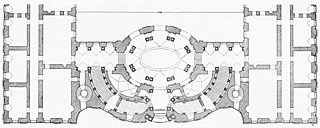Palazzo Carignano
The Palazzo Carignano is a historic building in the center of the northern Italian city of Turin . It was once the residence of the eponymous princes of Carignan , a branch of the House of Savoy . It is located on Via Accademia delle Scienze and now houses the Museo nazionale del Risorgimento .
history
The construction of the Palazzo Carignano as a suitable residence for the Savoyen-Carignan family was commissioned by Emmanuel Philibert Amadeus , the eldest son of Thomas Franz von Savoyen-Carignan . In 1679, work began according to plans by the Savoy architect Guarino Guarini .
Between 1848 and 1865 the palace served as the seat of the House of Representatives of the Subalpine Parliament . With the founding of the united Kingdom of Italy in 1861, the Palazzo Carignano became too small in its previous structure and therefore expanded. When the Italian capital was moved from Turin to Florence in 1865 , the Palazzo Carignano lost its function. Since then it has housed various institutions and cultural facilities.
architecture
Guarini designed a spacious building made of exposed brick on a square plot of land. The middle section of the baroque west facade has an unusual design to this day. The wave-like concave-convex-concave rhythm is based on Francesco Borromini's Roman church San Carlo alle Quattro Fontane . Behind the curve there is an elliptically shaped tower. The main building surrounds a large courtyard. The former garden facade, however, was designed rather simply.
The renovation continued until 1871 after Parliament had moved. Above all, the former garden facade and now the east facade after the demolition of the garden walls was redesigned. It got an eclectic look with pillars and pilasters made of white stone and red stucco. The former garden of the Palazzo Carignano was transformed into the Piazza Carlo Alberto, now one of the most important squares in Turin old town. Its center is adorned with a bronze equestrian monument by Carlo Alberto from 1861. The former stables on the east side of the square, renovated in a classicist style in 1790, now house the Turin National Library .
Others
The palace is, among other things, the birthplace of the later Italian king Vittorio Emanuele II. A frieze designed by Carlo Ceppi on the gable of the central axis of the main facade with the inscription QVI NACQVE EMANVELE VICTOR II (German: "Emanuele Victor II was born") reminds of this . . It was added in 1884, but stylistically fits into the rest of the baroque facade. Furthermore, Marie-Louise of Savoy-Carignan , called princesse de Lambelle , a confidante of Marie Antoinette, was born here in 1749 .
literature
- Heinz Schomann: Piedmont, Liguria, Aosta Valley. Art monuments and museums , (Reclam's Art Guide Vol. 1,2) Stuttgart: Reclam, 1982, pp. 476–479.
Web links
Coordinates: 45 ° 4 '8.2 " N , 7 ° 41' 8.1" E





